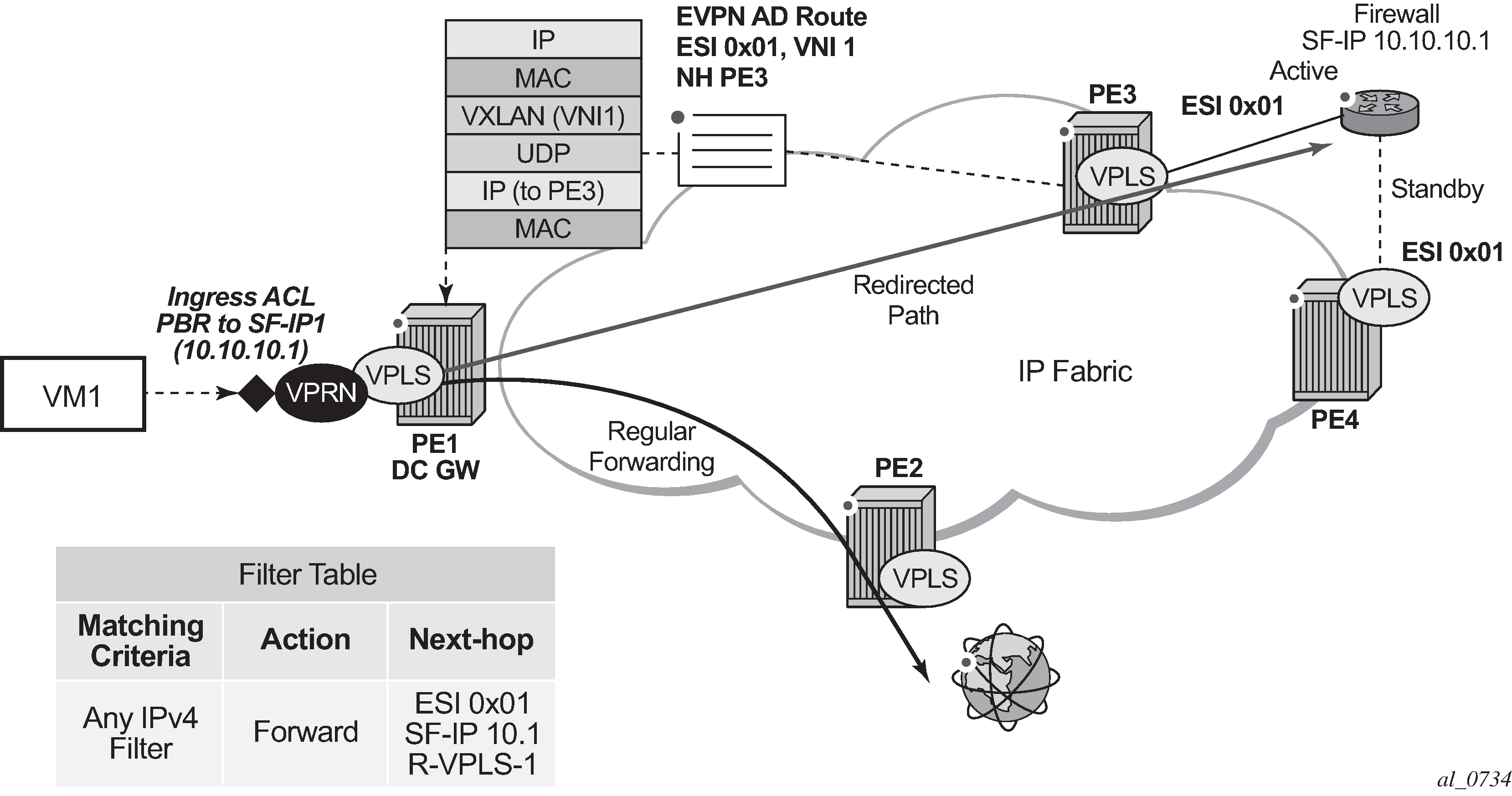Figure: PBR to ESI function shows the 7750 SR, 7450 ESS, and 7950 XRS Service Chaining integration with the Nuage VSP on L2-DOMAIN-IRB domains. In this example, the DC gateway, PE1, is connected to an L2-DOMAIN-IRB that exists in the DC and must redirect the traffic to the Service Function SF-1 with IP address 10.10.10.1. The regular Layer 3 forwarding procedures would have taken the packets to PE2, as opposed to SF-1.

In this case, an operator must configure a PBR match/action filter policy entry in an IPv4 ingress access or network filter deployed on IES/VPRN interface using CLI, SNMP or NETCONF management interfaces. The PBR target identifies first service function in the chain (ESI 0x01 in Figure: PBR to ESI function, identifying where the Service Function is connected and the IPv4 address of the SF) and EVPN VXLAN egress interface on the PE (VPRN routing instance and R-VPLS interface name). The BGP control plane together with ESI PBR configuration are used to forward the matching packets to the next-hop in the EVPN-VXLAN data center chain (through resolution to a VNI and VTEP). If the BGP control plane information is not available, the packets matching the ESI PBR entry is, by default, forwarded using regular routing. Optionally, an operator can select to drop the packets when the ESI PBR target is not reachable.
The following filter configuration shows an example of a PBR rule redirecting all the matching packets to an ESI.
*A:PE1>config>filter>ip-filter# info
----------------------------------------------
default-action forward
entry 10 create
match
dst-ip 10.10.10.253/32
exit
action
forward esi ff:00:00:00:00:21:5f:00:df:e5 sf-ip 10.10.10.1 vas-
interface "evi-301" router 300
exit
pbr-down-action-override filter-default-action
exit
----------------------------------------------
In this use case, the following are required in addition to the ESI: the sf-ip (10.10.10.1 in the example above), router instance (300), and vas-interface.
The sf-ip is used by the system to know which inner MAC DA it has to use when sending the redirected packets to the SF. The SF-IP is resolved to the SF MAC following regular ARP procedures in EVPN-VXLAN.
The router instance may be the same as the one where the ingress filter is configured or may be different: for instance, the ingress PBR filter can be applied on an IES interface pointing at a VPRN router instances that is connected to the DC fabric.
The vas-interface refers to the R-VPLS interface name through which the SF can be found. The VPRN instance may have more than one R-VPLS interface, therefore, it is required to specify which R-VPLS interface to use.
When the filter is properly applied to the VPRN or IES service (VPRN-300 in this example), it shows 'Active' in the following show commands as long as the Auto-Discovery route for the ESI is received and imported and the SF-IP resolved to a MAC address.
*A:PE1# show filter ip 1
===============================================================================
IP Filter
===============================================================================
Filter Id : 1 Applied : Yes
Scope : Template Def. Action : Forward
System filter: Unchained
Radius Ins Pt: n/a
CrCtl. Ins Pt: n/a
RadSh. Ins Pt: n/a
PccRl. Ins Pt: n/a
Entries : 1
Description : (Not Specified)
-------------------------------------------------------------------------------
Filter Match Criteria : IP
-------------------------------------------------------------------------------
Entry : 10
Description : (Not Specified)
Log Id : n/a
Src. IP : 0.0.0.0/0
Src. Port : n/a
Dest. IP : 10.16.0.253/32
Dest. Port : n/a
Protocol : Undefined Dscp : Undefined
ICMP Type : Undefined ICMP Code : Undefined
Fragment : Off Src Route Opt : Off
Sampling : Off Int. Sampling : On
IP-Option : 0/0 Multiple Option: Off
TCP-syn : Off TCP-ack : Off
Option-pres : Off
Egress PBR : Undefined
Match action : Forward (ESI) Active
ESI : ff:00:00:00:00:21:5f:00:df:e5
SF IP : 10.10.10.1
VAS If name: evi-301
Router : 300
PBR Down Act : Forward (filter-default-action) Ing. Matches : 3 pkts (318 bytes)
Egr. Matches : 0 pkts
===============================================================================
*A:PE1# show service id 300 es-pbr
===============================================================================
L3 ES PBR
===============================================================================
SF IP ESI Users Status
Interface MAC
VTEP:VNI
-------------------------------------------------------------------------------
10.10.10.1 ff:00:00:00:00:21:5f:00:df:e5 1 Active
evi-301 d8:47:01:01:00:0a
192.0.2.71:7171
-------------------------------------------------------------------------------
Number of entries : 1
-------------------------------------------------------------------------------
=================================================================================
In the FDB for the R-VPLS 301, the MAC address is associated with the VTEP and VNI specified by the AD route, and not by the MAC/IP route anymore. When a PBR filter with a forward action to an ESI and SF-IP (Service Function IP) exists, a MAC route is auto-created by the system and this route has higher priority that the remote MAC, or IP routes for the MAC (see BGP and EVPN route selection for EVPN routes).
The following shows that the AD route creates a new EVPN-VXLAN binding and the MAC address associated with the SF-IP uses that 'binding':
*A:PE1# show service id 301 vxlan
===============================================================================
VPLS VXLAN, Ingress VXLAN Network Id: 301
===============================================================================
Egress VTEP, VNI
===============================================================================
VTEP Address Egress VNI Num. MACs Mcast Oper State L2 PBR
-------------------------------------------------------------------------------
192.0.2.69 301 1 Yes Up No
192.0.2.71 301 0 Yes Up No
192.0.2.71 7171 1 No Up No
-------------------------------------------------------------------------------
Number of Egress VTEP, VNI : 3
-------------------------------------------------------------------------------
===============================================================================
*A:PE1# show service id 301 fdb detail
===============================================================================
Forwarding Database, Service 301
===============================================================================
ServId MAC Source-Identifier Type Last Change
Age
-------------------------------------------------------------------------------
301 d8:45:ff:00:00:6a vxlan-1: EvpnS 06/15/15 21:55:27
192.0.2.69:301
301 d8:47:01:01:00:0a vxlan-1: EvpnS 06/15/15 22:32:56
192.0.2.71:7171
301 d8:48:ff:00:00:6a cpm Intf 06/15/15 21:54:12
-------------------------------------------------------------------------------
No. of MAC Entries: 3
-------------------------------------------------------------------------------
Legend: L=Learned O=Oam P=Protected-MAC C=Conditional S=Static
===============================================================================
For Layer 2, if the AD route is withdrawn or the SF-IP ARP not resolved, the filter is inactive again. The user can control whether the matching packets are dropped or forwarded if the PBF target cannot be resolved by BGP.